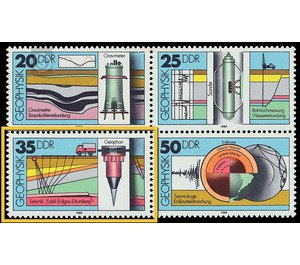geophysics - Germany / German Democratic Republic 1980 - 35 Pfennig
Theme: Devices, Items & Instruments
| Country | Germany / German Democratic Republic |
| Issue Date | 1980 |
| Face Value | 35.00 |
| Color | multi-colored blue |
| Perforation | K 13:12 1/2 |
| Printing Type | offset |
| Stamp Type | Postage stamp |
| Item Type | Stamp |
| Chronological Issue Number | 2301 |
| Chronological Chapter | GER-DDR |
| SID | 587115 |
| In 10 Wishlists | |
Geophysics The Ministry of Posts and Telecommunications of the German Democratic Republic publishes four multicolored special postage stamps on the subject of geophysics. In geological exploration, geophysical measurements on the surface of the earth and in well-drilled wells (well logging) play an important role today, especially with regard to reducing the costly drilling that is still required. The numerous methods used are based on the utilization of natural and artificial physical fields (eg gravitational and magnetic field of the earth, generated electric and acoustic fields) as well as the different physical properties (eg density, magnetic susceptibility, electrical conductivity, propagation velocity of sound waves) of the different rock types. In this case, even with modern electronic measuring devices and data processing on powerful computers usually only indirect statements about possible deposits can be obtained. The most significant benefit of geophysical results is the potential optimization of well approaches and the increase in information yield from wells. The geological industry and the mining industry of the GDR use geophysics as one of the most important means of rationalization in the forced exploration and promotion of domestic raw materials. By far the greater part of all field and borehole geophysical work in the GDR is provided by the VEB Geophysik Leipzig, which also develops and produces the majority of the necessary measuring equipment. The fulfillment of the planned tasks of this enterprise is significantly promoted by the direct support of Soviet specialists as well as by a manifold cooperation with partner institutions in the USSR and other socialist countries as well as academy and higher education institutions of the GDR. 35-pfennig-Wert- Seismik / Oil-gas exploration The exploration of oil and gas are by far the world's largest expenditures by geophysics. The main reason for this is that a sufficiently detailed detection of höffiger structures to several thousand m depth practically succeed only with the seismic as the most expensive and technically complex method. The principle of this method is the generation of sound waves by means of blasting just below the earth's surface or by mechanical excitation on this. The sound waves propagate at different speeds in the rock layers and are refracted and partly reflected at the layer boundaries. The echoes returning to the earth's surface - referred to as reflection waves - are registered with the aid of a large number of special receivers, the so-called geophones, and fed to a complicated electronic recording device. After extensive data processing, you gain a fairly detailed image of the background structure as a prerequisite for the optimal approach of deep drilling. The motif shows in a very simplified form the measuring principle (wave rays in a layer profile, wave reception at several points) as well as a geophone.


